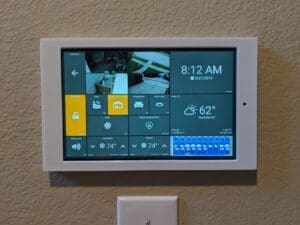Imagine living in a world where your home anticipates your needs, making life more convenient and comfortable. With the evolution of technology, this is no longer just a futuristic dream. Smart home automation systems have emerged as the game-changers in the world of residential living. In this article, we will explore the top seven smart home automation systems that are revolutionizing the way we live, providing seamless integration and control over various aspects of our daily routines. From lighting and security to temperature and entertainment, these systems offer a glimpse into the future of smart living. So, sit back, relax, and let’s embark on an exciting journey to discover the amazing possibilities that await in our homes.
Amazon Echo
Overview
The Amazon Echo is a smart speaker developed by Amazon. It is equipped with a voice-controlled intelligent personal assistant called Alexa, which can interact with the devices connected to the Echo and perform various tasks such as playing music, answering questions, controlling smart home devices, and more. The Echo is designed to seamlessly integrate into your home and provide a convenient way to control and automate your daily activities.
Features
The Amazon Echo comes with a range of impressive features that make it a popular choice among smart home enthusiasts. It has a high-quality speaker that delivers crisp and clear sound, making it ideal for playing music or listening to your favourite podcasts. The built-in voice control feature allows you to simply use your voice to interact with Alexa and control your smart home devices. Additionally, the Echo can connect to other smart home devices such as lights, thermostats, and security systems, allowing you to create a fully automated and interconnected home environment.
Advantages
One of the major advantages of the Amazon Echo is its compatibility with a wide range of smart home devices. Whether you have smart lights, thermostats, or security cameras, the Echo can seamlessly integrate with them and provide a centralized control hub. This means that you can control all your smart devices using just your voice, saving you time and effort. Additionally, the Echo continuously learns and improves its performance over time, adapting to your preferences and providing personalized recommendations and responses.
Disadvantages
One potential disadvantage of the Amazon Echo is its reliance on an active internet connection. Without internet access, the device’s functionality is limited, as it heavily relies on cloud processing for most tasks. Additionally, some users may have concerns about privacy, as the device is constantly listening for its wake word. While Amazon has implemented measures to address these concerns, it is important to be aware of the potential risks associated with having a device that is always listening in your home.
Google Nest Hub
Overview
The Google Nest Hub, formerly known as the Google Home Hub, is a smart display that incorporates the functionality of a smart speaker with a touchscreen display. It is powered by Google Assistant and offers a wide range of features to control your smart home devices, play music, display information, and more. The Nest Hub is designed to be a central hub for all your smart home needs, providing convenience and ease of use.
Features
One of the standout features of the Google Nest Hub is its vibrant and responsive touchscreen display. This allows you to not only use your voice to interact with Google Assistant but also to tap and swipe on the screen to control your smart home devices or browse through photos and videos. The Nest Hub also offers personalized recommendations based on your preferences and usage patterns, making it a truly intelligent and adaptive device.
Advantages
The Google Nest Hub offers seamless integration with other Google services and devices, such as Chromecast and Nest security cameras. This integration allows you to easily cast content to your Nest Hub or view live feeds from your security cameras, enhancing the overall functionality and convenience of the device. Additionally, the Nest Hub can provide visual responses to your queries, making it easier to understand and interact with the information provided by Google Assistant.
Disadvantages
One potential disadvantage of the Google Nest Hub is its limited compatibility with third-party smart home devices compared to the Amazon Echo. While it works well with Google-compatible devices, it may not be as versatile when it comes to integrating with devices from other brands. Additionally, some users may find the size of the touchscreen display to be too small for certain tasks, such as watching videos or reading articles.
Apple HomeKit
Overview
Apple HomeKit is a comprehensive smart home platform developed by Apple. It provides a centralized control hub for all your smart home devices, allowing you to easily manage and automate your home environment. HomeKit is compatible with a wide range of devices, offering a seamless and secure integration with your Apple ecosystem.
Features
One of the key features of Apple HomeKit is its focus on privacy and security. Apple has implemented strict security measures to ensure that your personal data and connected devices are protected. HomeKit also offers a user-friendly interface, allowing you to easily set up and control your smart home devices through the Home app on your iPhone, iPad, or Mac. Additionally, HomeKit supports advanced automation and scene creation, allowing you to create personalized routines and schedules for your devices.
Advantages
Apple HomeKit offers seamless integration with other Apple devices and services, such as Siri. This allows you to control your smart home devices using your voice or through the built-in Home app on your Apple devices. HomeKit also offers robust automation capabilities, allowing you to create complex routines and scenes that can be triggered by various conditions or events. The emphasis on privacy and security is another major advantage, providing peace of mind for users concerned about the security of their smart home devices.
Disadvantages
One potential disadvantage of Apple HomeKit is its limited compatibility with non-HomeKit devices. While Apple continues to expand its list of supported devices, there may still be some devices that are not compatible with the platform. This may limit your options when it comes to choosing smart home devices. Additionally, HomeKit relies on an Apple device as the control hub, which means that you need to have an iPhone, iPad, or HomePod to fully harness the capabilities of the platform.
Samsung SmartThings
Overview
Samsung SmartThings is a robust smart home automation system that allows you to control and monitor your smart home devices from a single app. SmartThings offers compatibility with a wide range of devices and provides an intuitive interface for managing your home automation needs.
Features
One of the standout features of Samsung SmartThings is its versatility and compatibility with various smart devices. Whether you have smart lights, cameras, door locks, or thermostats, SmartThings can connect and control them all. The platform also offers advanced automation capabilities, allowing you to create custom routines and scenarios for different situations. Additionally, SmartThings offers integration with voice assistants like Amazon Alexa and Google Assistant, providing multiple control options.
Advantages
Samsung SmartThings offers a wide range of compatible devices, making it a versatile option for homeowners who already have a mix of different smart devices. The platform’s intuitive app interface makes it easy to set up and manage your devices, and the automation capabilities allow you to create personalized routines based on your preferences and needs. The integration with popular voice assistants also adds convenience, as you can control your smart home devices with just your voice.
Disadvantages
One potential disadvantage of Samsung SmartThings is the complexity of the setup process. While the app interface is user-friendly, the initial setup may require more technical knowledge compared to other smart home automation systems. Additionally, some users have reported occasional connectivity issues or delays with SmartThings devices, which may affect the overall user experience. It is important to consider these factors when choosing a smart home automation system.
Hubitat Elevatio n
Overview
Hubitat Elevation is a locally-controlled smart home automation hub that offers a high level of privacy and independence from cloud services. It is designed to operate entirely within your home network, providing enhanced security and reliability.
Features
One of the key features of Hubitat Elevation is its local processing capability. Unlike many other smart home platforms, Hubitat does not rely on cloud services for its operation. This means that your data and device control remain within your home network, reducing potential privacy concerns and minimizing the impact of internet outages. Hubitat Elevation also supports a wide range of devices and protocols, ensuring compatibility with various smart home devices.
Advantages
One major advantage of Hubitat Elevation is its ability to function even when the internet connection is down. By relying on local processing, Hubitat ensures that your smart home devices continue to work as intended without the need for internet access. This level of reliability makes it an attractive option for users who prioritize uninterrupted automation and control. Additionally, Hubitat Elevation allows for advanced customization and rule creation, empowering users to create unique and complex automation routines tailored to their specific needs.
Disadvantages
One potential disadvantage of Hubitat Elevation is the learning curve associated with its advanced customization options. While the platform offers extensive capabilities for creating custom rules and automations, the setup process may require more technical knowledge compared to other systems. Additionally, Hubitat Elevation’s user interface may not be as visually appealing or intuitive as some of the other smart home automation platforms. It is important to consider your technical proficiency and preferences before choosing Hubitat Elevation.
Wink Hub 2
Overview
The Wink Hub 2 is a smart home hub that offers compatibility with a wide range of smart home devices. It provides a centralized control hub for managing and automating your smart home, offering convenience and ease of use.
Features
One of the notable features of the Wink Hub 2 is its wide device compatibility. It supports a large number of popular smart home devices, including lights, thermostats, locks, and more. This allows you to easily integrate and control your existing devices within a unified system. The Wink Hub 2 also offers a user-friendly app interface, making it easy to set up and manage your devices. Additionally, the Wink ecosystem supports various scheduled and automated routines, allowing you to create personalized scenarios for different situations.
Advantages
The Wink Hub 2’s extensive device compatibility makes it a versatile option for homeowners who already have a mix of different smart devices. The user-friendly app interface facilitates quick and easy device setup and control. The ability to create personalized routines and schedules adds convenience, allowing you to automate various tasks and control your devices with just a few taps. Additionally, the Wink Hub 2 provides reliable performance and connectivity, contributing to a seamless smart home experience.
Disadvantages
One potential disadvantage of the Wink Hub 2 is its reliance on cloud services for certain features and functionality. While the hub can still operate locally without internet access, some features may be limited or unavailable during internet outages. Additionally, some users have reported occasional connectivity issues or compatibility problems with certain devices. It is important to verify the compatibility of your existing devices before choosing the Wink Hub 2.
Logitech Harmony
Overview
Logitech Harmony is a popular smart home automation system that focuses on home entertainment control. It allows you to consolidate and control all your entertainment devices, such as TVs, sound systems, and streaming devices, from a single remote or app.
Features
The Logitech Harmony system offers a range of features to simplify and streamline your home entertainment experience. With the Harmony remote or app, you can control multiple devices simultaneously with just a few taps. The Harmony database contains a vast library of device codes, making it easy to set up and control your devices. The system also supports advanced features like activity-based control, which allows you to create personalized routines for different entertainment scenarios, such as watching TV or playing games.
Advantages
One major advantage of Logitech Harmony is its ability to consolidate and control multiple entertainment devices with a single remote or app. This eliminates the need for multiple remotes and simplifies the process of switching between different devices. The extensive device compatibility and database ensure that most devices can be easily integrated and controlled. Additionally, the activity-based control feature adds convenience, allowing you to automate the power-on and power-off sequences and customize your home entertainment experience.
Disadvantages
One potential disadvantage of Logitech Harmony is its focus solely on home entertainment control. While it does an excellent job of consolidating and controlling entertainment devices, it may not offer the same level of automation and control for other aspects of your smart home, such as lighting or security. Additionally, some users have reported occasional connectivity issues or compatibility problems with certain devices. It is important to consider your specific needs and priorities when choosing a smart home automation system.
Vivint Smart Home
Overview
Vivint Smart Home is a professionally-installed smart home automation system that offers a range of comprehensive features to enhance the security and convenience of your home. The system includes various smart devices, such as security cameras, door locks, thermostats, and more, all controlled through a centralized hub.
Features
Vivint Smart Home offers a wide range of features designed to enhance the security and convenience of your home. The system includes professional installation and monitoring, ensuring that your smart devices are properly set up and monitored for any potential issues. The Vivint app allows you to control and monitor your devices from anywhere, providing peace of mind and convenience. Additionally, the system offers advanced features such as smart detection, which can automatically adjust settings based on occupancy or specific events.
Advantages
One major advantage of Vivint Smart Home is the professional installation and monitoring services. This ensures that your smart devices are properly installed and set up, providing optimal performance and security. The Vivint app offers a user-friendly interface, making it easy to control and monitor your devices remotely. The advanced features, such as smart detection and integrated security systems, enhance the overall security and convenience of your home.
Disadvantages
One potential disadvantage of Vivint Smart Home is the higher cost associated with the professional installation and monitoring services. This may make it less accessible for some homeowners, especially those on a tight budget. Additionally, the system relies on professional installation, which means that you may have limited control over the setup and configuration of your devices. It is important to consider your budget and preferences when choosing a smart home automation system.
Abode
Overview
Abode is a DIY smart home security and automation system that offers a range of features to protect and monitor your home. The system includes various devices such as sensors, cameras, and door locks, all controlled through a user-friendly app.
Features
Abode offers a comprehensive set of features designed to enhance the security and automation of your home. The system includes various sensors, such as motion sensors and door/window sensors, which can detect and alert you to any potential intrusions. The Abode app allows you to control and monitor your devices remotely, providing peace of mind and convenience. The system also offers integration with other smart home devices, allowing you to create customized automation routines and scenarios.
Advantages
One major advantage of Abode is its DIY nature, which allows homeowners to install and configure the system according to their preferences. This provides flexibility and control over the setup process. The Abode app offers a user-friendly interface, making it easy to control and monitor your devices remotely. The system’s wide device compatibility allows for integration with other smart home devices, providing enhanced automation and convenience.
Disadvantages
One potential disadvantage of Abode is the need for self-installation and configuration. While some homeowners may prefer the DIY approach, others may prefer the convenience of professional installation. Additionally, some users have reported occasional connectivity issues or compatibility problems with certain devices. It is important to consider your technical proficiency and preferences when choosing a smart home automation system.
Conclusion
In conclusion, the market is flooded with a variety of smart home automation systems, each offering its own set of features, advantages, and disadvantages. The Amazon Echo, Google Nest Hub, Apple HomeKit, Samsung SmartThings, Hubitat Elevation, Wink Hub 2, Logitech Harmony, Vivint Smart Home, and Abode are all popular options worth considering.
The Amazon Echo stands out with its wide range of compatible devices and continuous learning capabilities. The Google Nest Hub excels with its vibrant touchscreen display and seamless integration with Google services. Apple HomeKit prioritizes privacy and security while offering a user-friendly interface. Samsung SmartThings boasts versatility and accessibility across various smart devices. Hubitat Elevation offers enhanced privacy and reliability with local processing. The Wink Hub 2 impresses with its extensive device compatibility and user-friendly app interface. Logitech Harmony shines in consolidating and controlling home entertainment devices. Vivint Smart Home provides professional installation and monitoring services, ensuring optimal performance and security. Abode offers a DIY approach with customizable automation and integration capabilities.
When choosing a smart home automation system, it is crucial to consider factors such as device compatibility, ease of use, privacy and security measures, customization options, and budget. Assessing your specific needs and priorities will help determine the most suitable system for your home.



